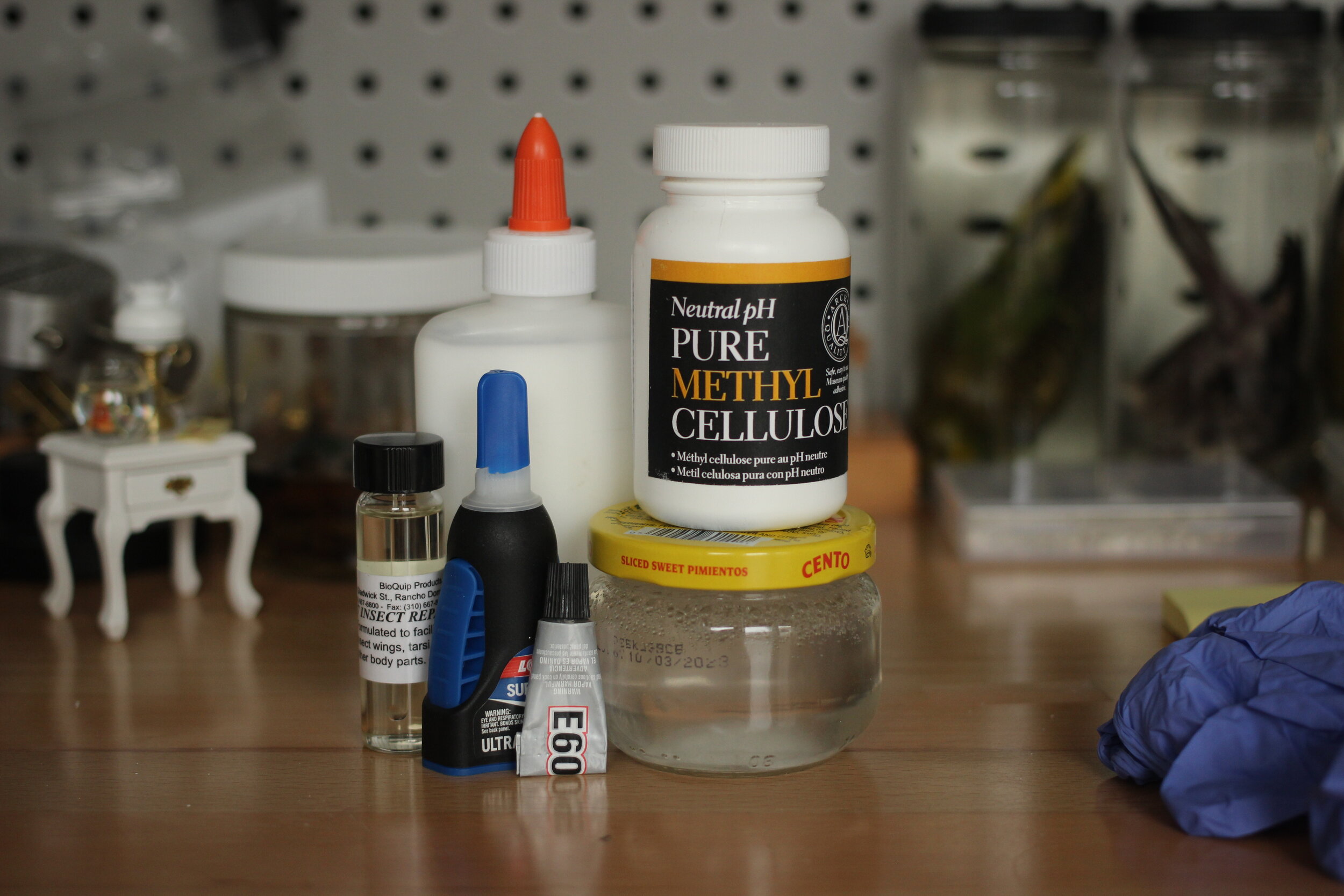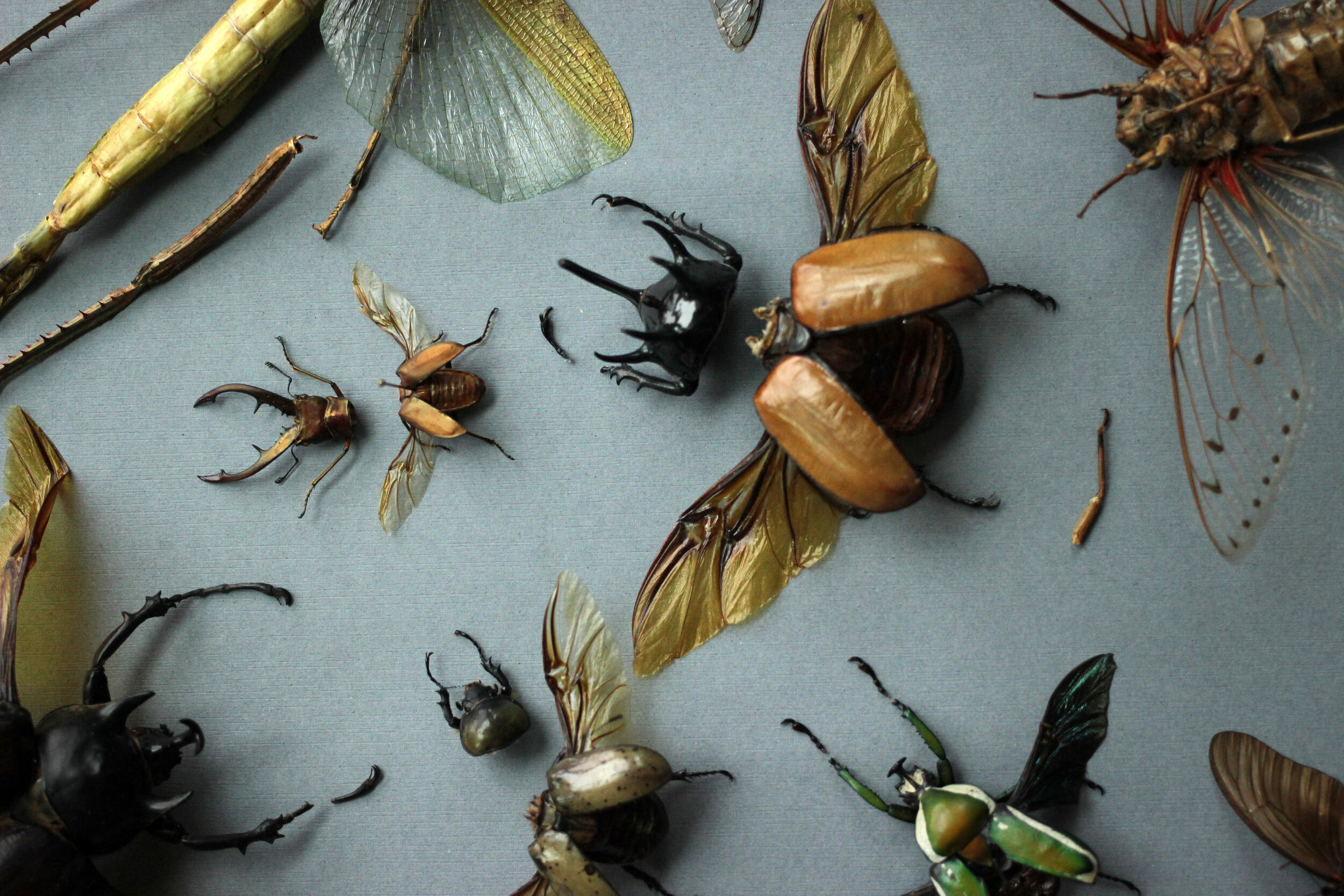This is a comparison of all of the adhesives I keep in my studio for making repairs in my work. Entomology art is so fun to make, but insects (and other invertebrates) are fragile and sometimes accidents happen. Whether you received your specimen with a broken antennae right from your broker or you got really excited about a huge beetle and made your boyfriend take your picture holding it and you broke off two legs in the process (who, me?), you’re gonna need some glue. This post contains affiliate links.
These are my five adhesives. I mixed the methyl cellulose in a pimento jar, and it lasts a long time.
These adhesives can be used to fix a butterfly wing, reattach a beetle leg, secure a cicada’s head back onto its body, and even if your insects are already perfectly intact these glues can also be used to put your specimen(s) into a shadow box!
I work in large batches and if specimens break I set them aside in my Dead Bug Hospital™ and then I do repairs in large batches. This worked out perfectly for writing this adhesive guide because I was able to use one right after the next for a great comparison rather than writing this from memory. Here are all of the insects I fixed.
I keep five glues in my studio right now. If I experiment with more I will add them to this guide. Without further ado, here they are. Reviews, notes, and more are below.
Now for the reviews!
Glue type: LocTite Gel, a brand of super glue (cyanoacrylate glue)
Consistency: Gel toothpaste, under eye cream
Odor: Acrid chemical smell
Application type: Comes in a squeeze bottle with a tiny applicator tip
Color when dry: Mostly clear with a whitish cast depending on the thickness
Reversible: No
Where to buy: Amazon, Michaels, hardware stores
Notes: Super glue comes in a number of consistencies but I always buy the gel kind so that I have control over the flow. This is the most caustic of any glues I will mention here and it dries very very brittle — so if you repair something but it gets bumped, it will snap again in the same spot but with the addition of dried glue. If you repair it a second time with super glue, it may be very noticeable. I would only use this glue for non-visible repairs, like attaching a head back onto a body. It works great for securing pins into shadow boxes but if I had the choice between this and E6000, even just for shadow boxes, I would choose E6000 every time. More on that below.
Super glue from any brand gives off fumes for a long while after application. Ensure that it has dried for quite a few days before sealing it under glass, because the fumes can bloom and create a dirty-looking cast on the inside of your glass. It’s easy to remove but wouldn’t it just be better to not have to do that in the first place?
Overall rating: 3/5
Glue type: BioQuip Insect Repair Adhesive
Consistency: Liquid, like watered-down dish soap. Just slightly more viscous than plain water.
Odor: Knocks your socks off, acrid chemical smell
Application type: Comes in a vial with a glass rod attached to the lid, the rod is the applicator
Color when dry: Clear and shiny
Reversible: No
Where to buy: BioQuip
Notes: This repair adhesive is PERFECT for small repairs. Torn wings? Yes. Detached antennae? Yes. Gotta fix some cilia? Yes. Use very sparingly. What I like to do is let most of the glue drip off the glass rod back into the vial and dab the tip of the applicator along the edges that need to be repaired until I can just barely see the adhesive. I use tweezers or forceps to replace the missing part in its correct position and blow very, very gently until the glue seems to hold on its own. It dries quite fast. This is a nice glue to have on hand for minor repairs of small invertebrates, but I would not recommend it for very large repairs because of the consistency. A more gel-like glue works better for large repairs because it has the volume to fill up cavities and stay in place, rather than dripping out. I would also not use this glue to secure any insects in their shadow boxes.
Overall rating: 5/5, will always stock this in my studio
Glue type: Lineco Methyl Cellulose
Consistency: Initially, powder. Once mixed, chocolate mousse, complete with airiness
Odor: Not noticeable at all
Application type: Brush
Color when dry: Clear
Reversible: Yes
Where to buy: Amazon
Notes: This is a very interesting adhesive. The container contains cellulose-based powder, which you mix with water according to the package instructions in a separate container. A little powder goes a long way so this glue is worth the investment. Leave for one hour or overnight and it magically turns into glue! This adhesive is acid-free and archival, originally formulated for creating and repairing books. Once mixed and left to set, the glue can be lifted out of the container on your brush in small pieces and pushed into the areas where you need it. It does not flow and does not have a liquid consistency at all. In my experience this is best used for larger repairs (missing heads, fallen legs from larger insects) rather than very tiny repairs given that it stays in place and will not flow smoothly to fill in gaps for repairs like antennae or small tarsi. I do like this adhesive a lot and it dries quite nicely, but remember the consistency of the original powder and keep in mind that this type of adhesive does not have shock absorbing qualities — I do not use this glue to secure insects in their shadow boxes.
Lineco Methyl Cellulose is reversible with water.
Overall rating: 4/5
Glue type: Elmer’s School Glue or Elmer’s Glue-All. See also: Aleene’s Tacky Glue.
Consistency: Runny, like melting ice cream
Odor: Old milk
Application type: Cap pops up, squeeze from the bottle
Color when dry: It says it dries clear, but it’s more like a milky color. There’s a milk theme here with this glue and if that grosses you out, I’m so sorry. To be fair it does have a drawing of a cow on the label (a variant of the character Elsie, because Elmer’s used to be owned by Borden) and used to be made from bovine and equine (cattle and horse) parts. You can read all about the strange history of Elmer’s here. Today it is made of PVA (polyvinyl acetate) and no animals are used in its production.
Reversible: Maybe, with water. The glue will soften and you could peel your parts away from each other and reattach if necessary. Keep in mind that this could become extremely messy.
Where to buy: Amazon, Michaels, and basically everywhere else in America. Even your grocery store probably sells Elmer’s in the office supply section near the paper towels, etc. so it’s easy to find in a pinch.
Notes: Elmer’s is an easy to find glue that is “good enough” to get the job done but it’s not amazing. As mentioned above, it does dry clear-ish with a white cast. This means you need to be quite sparing with it when it’s being used in a visible spot. It dries slightly flexible but still brittle. For the most success, squeeze out a “baby dot” of glue (the size of the head of a pin) and apply more only as needed. Wipe away excess before it dries if possible. I do not usually use Elmer’s for repairs unless literally nothing else is available. I do use it for securing pins into shadow boxes. If you do like the texture and are looking for an archival version, try finding rabbit skin glue made for bookbinding. Yes, it’s made from real rabbit skin.
Overall rating: 2/5
Glue type: E6000
Consistency: Thick gel, like silicone caulking or Vaseline
Odor: Mild chemical odor
Application type: Tube
Color when dry: Clear
Reversible: Not really, but you could try with acetone. Keep in mind the effect acetone may have on your specimen.
Where to buy: Amazon, Michaels
Notes: E6000 is my favorite glue and I have a lot of thoughts about it. While not considered to be archival, it is my favorite and I use it the most often out of all of my adhesives. It is very useful for making larger repairs such as attaching a head back onto a beetle or reattaching a cicada leg. It is not very useful for reattaching very small parts like antennae or mouth parts. The texture when it dries is somewhat soft, flexible, and rubbery. This is a positive attribute because this glue is shock absorbent compared to other adhesives — so if you ship your insects, or you move homes, insects repaired this way are much more likely to “survive” (that’s a joke because the bugs are dead) being jostled around on the journey.
E6000 comes in many sizes. At first glance, buying many small tubes seems more wasteful and less economical. However, this adhesive has a relatively short shelf life once opened. Even if you seal the cap completely, eventually the entire tube will harden into a weird gummy bear consistency which can still be squeezed out of the tube, it is slightly sticky but will no longer operate as an actual adhesive. For this reason, I choose to purchase the small tube sets and open one at a time. To create a very small opening, when I remove the cap I poke a tiny hole in the seal so only a small amount comes out at once. If I don’t use the whole tube immediately and it does the weird gel thing, I can just toss it and open a new small tube. If I did this with the large tubes I would be spending a lot more overall because I’d end up throwing away much more.
E6000 is easy to remove if you get it on your hands, just let it dry until it is tacky and then rub your hands together to get the glue off before washing. If you get E6000 on other surfaces and don’t notice until it dries, it can be cleaned off with acetone (check that acetone is safe to use on the surface you are trying to clean).
Once again, I repeat that this is not archival but will definitely last your entire lifetime. If I only have to fix something once, but there’s a slight chance it will erode from acid in 200 years, does it really matter if a piece of art I made for myself has a tiny bit of non-archival adhesive on it? I don’t think so. Long live E6000!
Overall rating: 5/5, will always stock this in my studio

